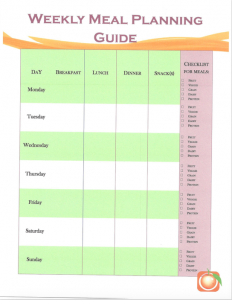Part 3 in our 4 part series on cooking at home. See the links to our first two parts here (part 1), and here (part 2).
Any behavior change takes time and energy, and when we’re used to eating out more often than eating at home, we need to practice patience while forming and practicing our new habits. This week’s blog focuses on the planning of our meals, and our 4th and final blog in the series next week will be on grocery shopping.
Dining at home has many advantages, including the ability to use healthier ingredients, set portions to a reasonable size, avoid food allergies, and save money. Not only will the tips herein enable us to save money by minimizing food waste, but eating at home is, on average, 75% less expensive than eating out. According to a recent Forbes survey, home-cooked meals average $4 per person, while meals out average $20 per person. A couple who eats out 3 times per week will look to save nearly $100 per week eating at home. Reducing from 3 to 2 meals out per week would save that couple almost $2100 in a year’s time, while further cutting to 1 meal out per week would net over $4000 annually. Think about these numbers when you’re taking the time and effort to eat at home and it should make the going a bit easier. Better yet, set aside $100 cash each week to see that money grow, and make a plan as to how you want to celebrate with your savings.
So you don’t have to practice as much patience with getting in the swing of dining at home, here are 3 steps in making the process of eating at home easier, faster, and less harried, and how to not waste money on foods that have to be tossed out.
Start with your schedule
I suggest you plan dinners a week at a time and grocery shop once a week also. Of course, you can flex to meet your needs. Look at any commitments or dinners you have already planned to eat out for the week. Once you have an idea of the number of nights you’ll be home, plan your meals. Eating at home doesn’t have to be elaborate; convenience foods from the grocery store can be a quick and healthy alternative to starting every meal from scratch. Click here for our free printable menu planning template.
Pencil in your entrees for the number of dinners you’ll eat at home. Figure in a night or two for leftovers if you’ll get more than one dinner from some of the meals. You can also freeze leftovers for a convenient meal another week, or make a different meal from the initial entree. For example, if you choose tri-tip with baked potato, broccoli, and mandarin orange sections with vanilla yogurt topping (note how I’ve included all 5 food groups here), you can make a second meal of beef stir-fry with the remaining steak.
Round out your meals with the 5 food groups
Your entree is protein-based, and may have whole grain and/or vegetable if it’s a casserole-type dish. If grain and veggie aren’t inherently included, add those items to your menu, and finish with fruit and dairy. Not only do you get a ton of nutrients by putting all 5 food groups in your meals, you will satisfy all of your taste buds as well with the varied flavors; sweet, salty, sour, bitter and unami (savory). Hitting the 5 taste buds with the 5 food groups is an important part of feeling satisfied and not just full after a meal.
Bonus NC Tip: purchasing meat in bulk and dividing into portions for individual meals before freezing saves money. Frozen and canned fruits and vegetables help eliminate food waste when we don’t get to the fresh varieties as soon as we’d planned, and this is another cost saving measure.
Start slow
You don’t have to eat every dinner from home, leftovers are great, prepped foods are OK too, and simple meals can be nutritious. Even a box of macaroni and cheese can convert to a more nutritious meal with the simple additions of frozen green beans and canned peaches. Search Pinterest and the internet for “simple” versions of meals you’re interested in trying, and have fun!
Next week, we’ll simplify grocery shopping and touch on meal prep.
Karen Fisher, MS, RDN, CDE is a dietitian in Reno, Nevada, happily promoting the benefits of healthy foods at her nutrition consulting firm, Nutrition Connection. Find her website at www.NutritionConnectionNV.com


{ 0 comments… add one now }